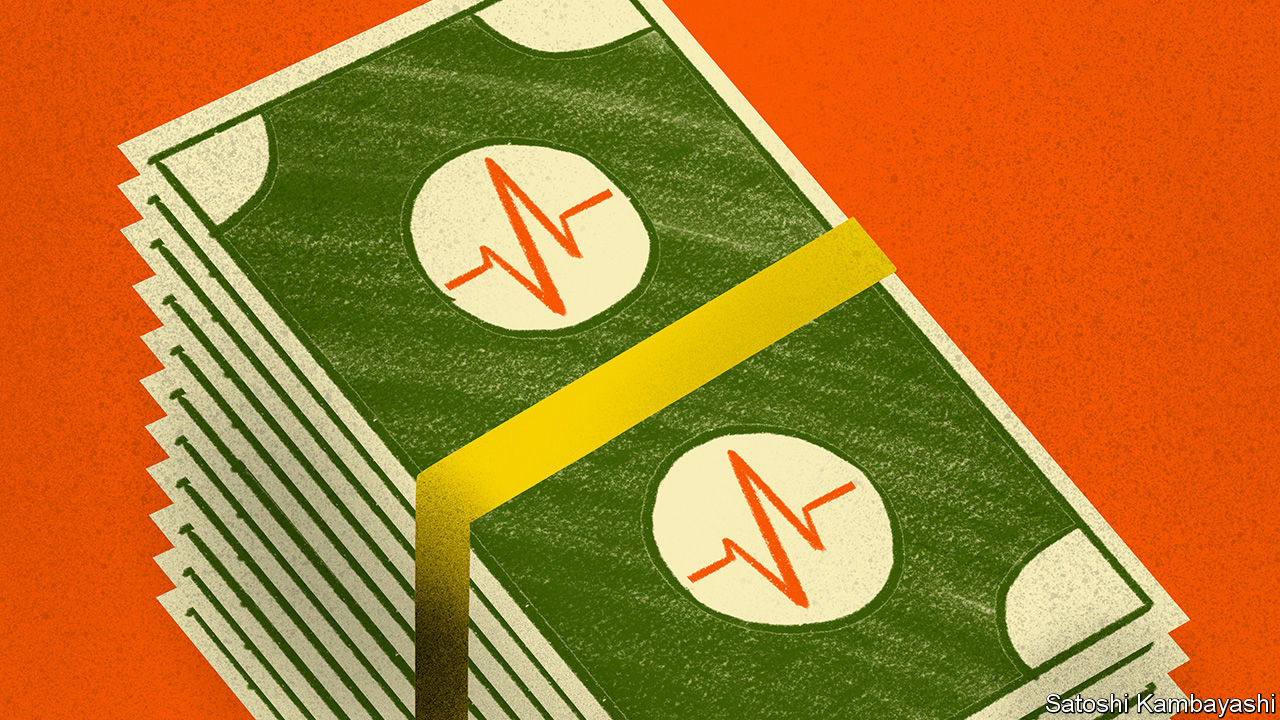Healthy returns
Private equity is piling into health care
High prices and stiff competition mean investors must think creatively

LAST month KKR, a private-equity firm, announced that it would buy Envision Healthcare, one of America’s largest providers of doctors to hospitals. The deal was valued at $9.9bn, including debt. If shareholders agree to the sale, it will be the largest in a string of health-care investments by KKR, including an ambulance service, a company that helps treat children with autism and a maker of medical devices.
“Ten years ago only a few private-equity houses had dedicated health-care teams,” says Dmitry Podpolny of McKinsey, a consultancy. “Today nearly everyone does.” Last year saw a frenzy of deal activity, the highest by value since the go-go year of 2007.
Private-equity funds are not the only ones keen on the industry. Institutional investors, tech-focused funds, generalist asset managers and corporate buyers are sniffing around, too. As they chase a limited number of targets, they are pushing up prices. Not high enough to dampen interest, however: health care is loved by investors for its resilience in downturns. It held up in 2000, when the dotcom bubble burst, and in 2008, during the financial crisis. People who need medical care rarely wait for an economic recovery. “Particularly late in the cycle, or if you’re leveraged, the sector can offer stability,” says Jim Momtazee of KKR.
But interest is not merely defensive. America’s health-care market has grown faster than GDP for decades and annual spending is now $3.5trn. Further growth worldwide will be fuelled by ageing populations, the rising prevalence of chronic diseases, new treatments and an expanding middle class. According to McKinsey, in 1990-2015 health care offered shareholders higher total returns than any other sector.
Health care has an added appeal for private-equity investors, says Bain, another consultancy. It has been comparatively untouched by the innovation, disruption and consolidation that have driven costs down elsewhere. Investors argue that they can add value by consolidating assets and making companies more efficient, for example with technology or better joint purchasing. Laboratories are a case in point. A decade ago most labs in America and Europe were small; now megalabs dominate. Dentists, radiologists, ophthalmologists and care homes are consolidating, too.
Investors are less vocal about complex systems of reimbursement, though they are another draw. Those receiving health care are rarely those who pay for it, which helps providers be opaque about charges. As payers try to control costs, particularly in America, they are shifting from reimbursing by treatment to reimbursing by outcome. In response, health-care firms are seeking to reposition themselves through mergers and acquisitions.
Recent months have seen a string of deals between payers and providers, such as the buy-out of Kindred Healthcare by Humana, a large American health insurer, together with TPG and Welsh Carson, two private-equity firms. During such corporate shake-ups, being private can be useful. “Public markets are impatient and focused on quarterly results,” says Kara Murphy of Bain. “With private capital you can bet on what a company could become rather than what it is.” The particular sensitivities associated with the industry are another consideration. “Given the extra scrutiny that the health-care industry gets, it’s often better for the company to be private,” she adds.
Corporate buyers looking to expand into new products or markets offer private-equity firms an exit route. An example is the sale in 2016 of Truven Health Analytics, a health-data cruncher, by Veritas Capital to IBM for $2.6bn. The tech giant paid more than double what Veritas had paid four years earlier. But the data firm was well matched with Watson, IBM’s artificial-intelligence platform, which it is promoting as a diagnostic tool.
High prices and stiff competition mean investors must think creatively. “When everything is expensive we look for quality assets in niche markets with high barriers to entry and high growth opportunities,” says Philippe Poletti of Ardian, a European private-equity firm. Lateral thinking led it to disinfectants. In 2013 it co-invested in Laboratoires Anios, a French maker of hand-sanitisers, cleaning materials for hospital equipment and the like. After bulking up the sales team and investing in innovation, it made five acquisitions, in Brazil, Turkey and elsewhere. And it identified a niche within a niche—products for cleaning and disinfecting endoscopes—which it thought it could dominate, for example by buying a producer of endoscope-cleaning machines (which in turn use Anios’s chemicals). When Ardian cashed out last year, turnover had expanded by 25% and earnings by 50%.
Public scrutiny of health-care provision, not to mention complex webs of national regulations and payments systems, mean that investors have often preferred products to services. It is easier to sell latex gloves or bandages than surgery across borders. This also helps explain why private equity has made greater inroads into American health care than into Europe’s smaller, more varied markets (where public systems have also often resisted private investment). But that very fragmentation may mean that Europe’s health-care market is next to fall.
Budget constraints are making governments there more open to private capital. Several countries, including Finland and Spain, are turning towards public-private partnerships and some investors hope that Britain’s struggling National Health Service will become more welcoming. “In Europe almost every country faces ageing populations and in 10-20 years they will need health care,” says one fund manager. “There’s a huge challenge in providing for that growing demand while increasing efficiency. PE can help solve that problem.”
Scarce assets, stiff competition, cheap debt and large amounts of “dry powder” make a volatile mix. “Valuations are very high, but I really can’t see an end in sight,” says Martin Gouldstone of Results Healthcare, an advisory firm. Such remarks normally suggest bubbles. But health care is not normal. Some parts may be hyped (bits of biotech and med-tech spring to mind). There will be disruption as big new actors such as Amazon barge in. But as long as human bodies fail, they will need fixing.
0 comments:
Publicar un comentario